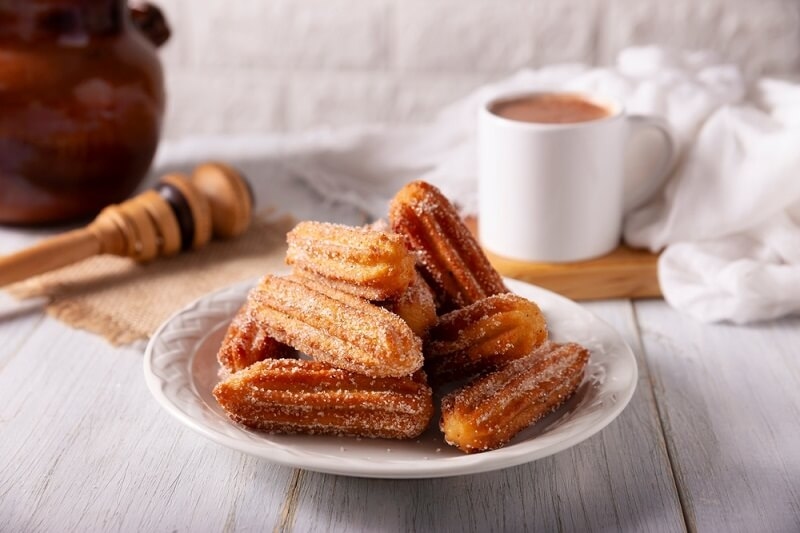
Spain may evoke in your mind pictures of vibrant tapas bars, late-night dinners, and seafood feasts. But what about the very first meal of the day? It might shock you to find out that Spanish breakfast habits are very different from what you expect.
This article is about the traditions, common foods, and why the Spanish chose these foods. With this, you will learn about some common foods that you can find in Spain for breakfast.
The way people eat in Spain has a great influence on the way they are spending the day. As the main meal (lunch) is usually scheduled at around 2:00 or 3:00 in the afternoon in Spain, breakfast is normally small. People quite often choose the option of having a small snack with coffee rather than a big meal of eggs, meat, and toast before going to work.
Breakfast in Spain is more adaptable. While some people might have a small meal at home, others may want to visit a café to eat something tasty and to enjoy a mid-morning break. Taking a break and meeting for coffee is an equally big part of the time for resting as it is for food.
One of the most frequently asked questions by visitors is why the Spanish breakfast is so light compared to other countries. There are several factors contributing to this:
This meal pattern calls for moderation. Spaniards do not gorge at breakfast; instead, they consume smaller quantities at more frequent intervals, using their meals as opportunities to enjoy food rather than simply satisfy hunger.
A typical Spanish breakfast is not an extensive one, but it is made up of a few simple and good-quality products. Some common examples of food that the Spanish eat in the morning are:
Instead of being one of those breakfast buffets where there are a lot of heavy foods, the food that you will find in Spain is light, modest, and enough to start the day without being too heavy on you.

A description of what the morning is like in Spain is incomplete without the mentioning of coffee with breakfast. The star of the first meal is coffee, and the Spaniards are very serious about it. The most frequent request is a café con leche, which is half coffee and half milk and goes very well with toast or a pastry.
Some people prefer to have a cortado, a stronger espresso with just a little milk, particularly if they want a quicker caffeine hit. In contrast to some countries, where coffee is a large drink to sip slowly, in Spain, it’s usually smaller in size but rich in flavor. A lot of people will even come for a quick cup standing at the bar before work.
One of the most delicious morning treats is churros with chocolate for breakfast. Churros are fried dough sticks, which are crispy on the outside and soft on the inside. They are dipped into a dense, rich hot chocolate that is more like a pudding than a drink.
Despite the fact that churros are not consumed on a daily basis, they are an integral part of Spanish breakfast customs, especially during weekends or during times of celebration. People in the community usually visit churrerías, small shops that specialize in churros, to savor this luxurious way of starting the day. For tourists, it’s an experience that they have to try, and it gives insight into the jolly and social aspect of Spanish food culture.
In case you crave for something salty, tostada with tomato Spain is a basic and the easiest option. Pan con tomate is a method of preparing a meal by rubbing fresh tomato over toasted bread, typically with a drizzle of olive oil and a little bit of salt. Some people may even use ham, cheese, or garlic with the dish to elevate the taste further.
This plain dish symbolizes the Spanish people's fondness for pure and natural products. Furthermore, it is not only nutritious but also incredibly satisfying. The meal is one of the most prevalent breakfast dishes that exist in many regions of Spain, including, Andalusia, and Catalonia.
In addition to churros, morning pastries have been cherished in Spain for generations. The list of the most common ones includes:
People prefer to have these together with coffee or juice, which makes breakfast feel more luxurious. Although they are sugary, they are not as heavy as the breakfasts of other countries.
The concepts remain comparable throughout the country; however, the regional differences have a significant impact on the Spanish breakfast customs. To give an illustration:
The differences indicate geographic and cultural influence when it comes to using local ingredients and regional traditions, and thus how varied Spanish regions even impact the very first meal of the day in Spain.
For Spaniards, breakfast is not merely the intake of food but an opportunity to socialize as well. It is very usual to see people on the lookout for a coffee and toast to meet a friend or co-worker in passing. These little meetings bring people together and spice up the daily routines. The social aspect of Spanish breakfast habits is as strong as what’s on the plate.
If you want to have breakfast in Spain as a tourist, you will find that many hotels offer a wide range of international breakfast options, including eggs, meat, and cereals. But if you really want to feel the Spanish way of life, you should mimic the locals. Eat a tostada with tomato, drink a café con leche, and eat churros with chocolate for breakfast at a local café.
The daily breakfast habit in Spain closely mirrors a society that holds dear the values of balance, quality, and social connection. Nothing significant is served; the day usually starts with a cup of coffee, toast, or pastry. If you look deeply into the reasons for eating late dinners, long lunches, and taking a mid-morning break, you will realize that these traditions are logical and that Spain is full of such old and new things.
You will uncover that in Spain, breakfast is not seen as just food but as a cultural epitome of savoring life, positive, light, and mouthwatering, one taste at a time.
This content was created by AI